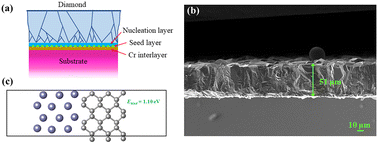Effective diamond deposition on Ti:sapphire with a Cr interlayer via microwave plasma chemical vapor deposition
Abstract
The application of diamonds for thermal management of solid-state lasers has recently attracted increasing interest. However, the problem of synthesizing high-performance diamonds has not been addressed, hindering the development of advanced heat management. Here, we deposited diamond by a microwave plasma chemical vapor deposition (MPCVD) method on a Ti:sapphire substrate to improve the thermal performance of the substrate by using a Cr interlayer, and the seeded Cr layer was effective in improving the adhesion between the diamond film and the substrate. The results were rationalized by using first-principles calculations, and it was shown that the stable interface adhesion was attributed to the strong carbon adsorption capability of the Cr surface, which favored the C–Cr bond formation at the interface. The catalysis of Cr results in an increase in the non-diamond phase, impeding interface binding. To address this, ∼0.2% oxygen was used during the deposition process. Raman spectroscopy showed that the diamond film deposited on the Cr interlayers was under compressive stresses of 1.46 and 0.97 GPa, and the thermal diffusion coefficient increased by 17%. This enhancement in performance offers a promising potential for the fabrication of high-power solid-state laser heat spreaders using diamond films.



 Please wait while we load your content...
Please wait while we load your content...